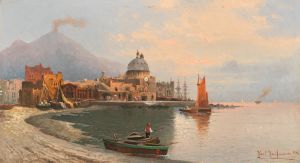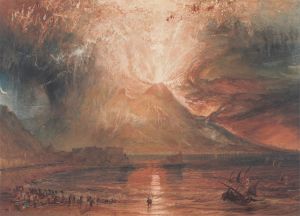
A view of Vesuvius from Posillipo, Naples
A hand-painted replica of Joseph Wright of Derby’s masterpiece A view of Vesuvius from Posillipo, Naples, meticulously crafted by professional artists to capture the true essence of the original. Each piece is created with museum-quality canvas and rare mineral pigments, carefully painted by experienced artists with delicate brushstrokes and rich, layered colors to perfectly recreate the texture of the original artwork. Unlike machine-printed reproductions, this hand-painted version brings the painting to life, infused with the artist’s emotions and skill in every stroke. Whether for personal collection or home decoration, it instantly elevates the artistic atmosphere of any space.
Joseph Wright of Derby, an eminent English landscape and portrait painter of the 18th century, is renowned for his dramatic use of light and shadow, a technique known as chiaroscuro. One of his notable works, "A View of Vesuvius from Posillipo, Naples," exemplifies his fascination with natural phenomena and the sublime, a theme prevalent in his oeuvre. This painting captures the majestic and somewhat foreboding presence of Mount Vesuvius as seen from Posillipo, a picturesque area in Naples, Italy.
Wright's journey to Italy between 1773 and 1775 was a significant period in his artistic development. During his Grand Tour, a customary trip through Europe undertaken by many artists and intellectuals of the time, Wright was exposed to the rich artistic heritage and dramatic landscapes of Italy. The eruption of Mount Vesuvius in 1774 provided him with a firsthand experience of the volcanic activity that had fascinated many artists and scientists of the era. This event likely inspired several of his works, including "A View of Vesuvius from Posillipo, Naples."
In this painting, Wright employs his signature chiaroscuro technique to highlight the contrast between the dark, brooding clouds and the fiery glow of the volcanic eruption. The composition is carefully balanced, with the tranquil waters of the Bay of Naples in the foreground providing a stark contrast to the tumultuous sky. The use of light not only enhances the dramatic effect but also draws the viewer's eye towards the central focus of the painting—the erupting Vesuvius.
Wright's depiction of Vesuvius is not merely a representation of a natural event but also an exploration of the sublime, a concept that evokes both awe and terror. The painting reflects the 18th-century fascination with the power and unpredictability of nature, a theme that resonated with the Romantic movement that followed. Wright's ability to capture the intensity and grandeur of such scenes contributed to his reputation as a master of atmospheric effects.
"A View of Vesuvius from Posillipo, Naples" is part of a series of works by Wright that explore volcanic eruptions and their impact on the landscape. These paintings were well-received by his contemporaries and continue to be admired for their technical skill and emotional depth. Wright's work not only documents a specific moment in time but also invites viewers to contemplate the broader relationship between humanity and the natural world.
Today, Joseph Wright of Derby is celebrated as one of the leading figures of the British Enlightenment, and his works are held in high esteem by art historians and enthusiasts alike. "A View of Vesuvius from Posillipo, Naples" remains a testament to his artistic vision and his ability to convey the awe-inspiring power of nature through the medium of paint.


















